display Oldsmobile Aurora 1998 Owner's Manuals
[x] Cancel search | Manufacturer: OLDSMOBILE, Model Year: 1998, Model line: Aurora, Model: Oldsmobile Aurora 1998Pages: 380, PDF Size: 19.75 MB
Page 71 of 380
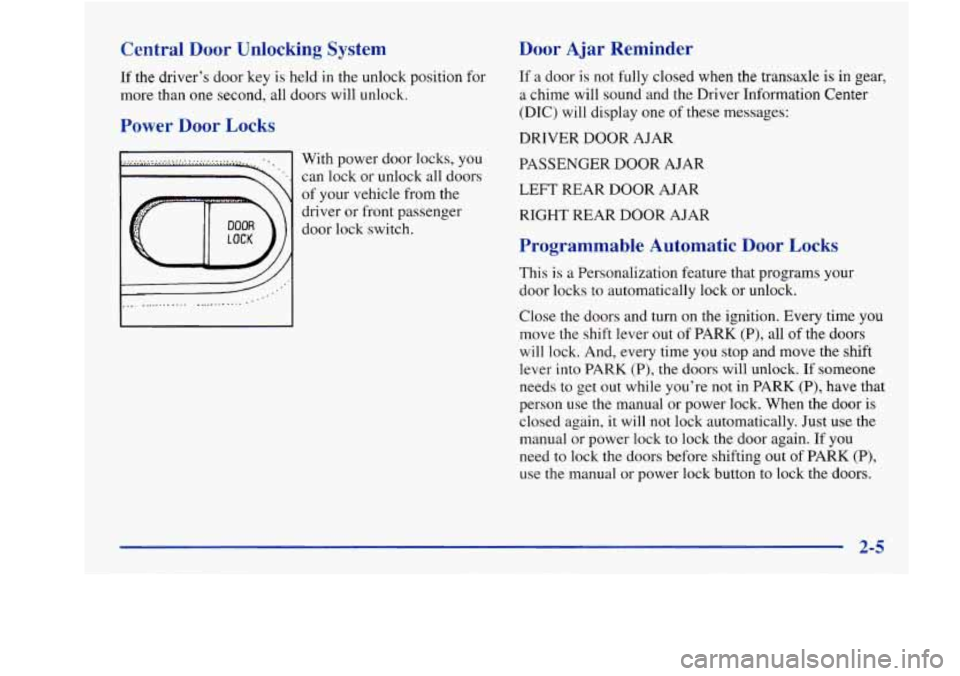
Central Door Unlocking System
If the driver’s door key is held in the unlock position for
more than one second, all doors will unlock.
Power Door Locks
With power door locks, you
can lock or unlock all doors
of your vehicle from the
driver
or front passenger
door lock switch.
Door Ajar Reminder
If a door is not fully closed when the transaxle is in gear,
a chime will sound and the Driver Information Center
(DIC) will display one of these messages:
DRIVER DOOR AJAR
PASSENGER DOOR AJAR
LEFT REAR DOOR AJAR
RIGHT REAR DOOR AJAR
Programmable Automatic Door Locks
This is a Personalization feature that programs your
door locks to automatically lock or unlock.
Close the doors and turn on the ignition. Every time you
move the shift lever out of PARK (P), all of the doors
will lock. And, every time you stop and move the shift
lever into PARK
(P), the doors will unlock. If someone
needs to get out while you’re not in PARK (P), have that
person use the manual
or power lock. When the door is
closed again, it will not lock automatically. Just use the
manual or power lock to lock the door again. If
you
need to lock the doors before shifting out of PARK (P),
use the manual or power lock button to lock the doors.
A 2-5
Page 86 of 380
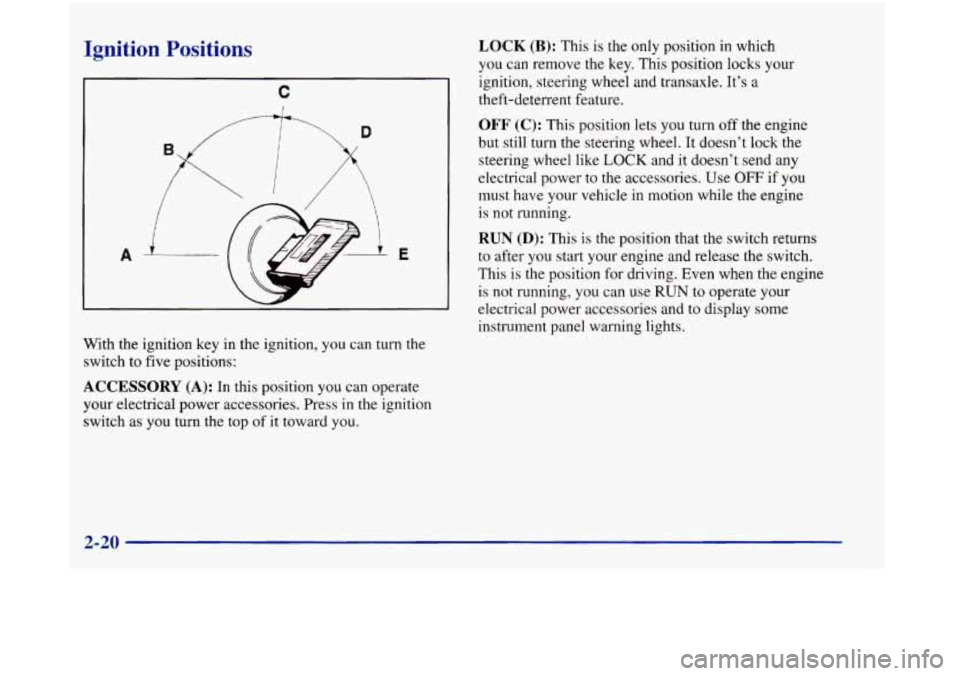
Ignition Positions
C
I
A E
With the ignition key in the ignition, you can turn the
switch to five positions:
ACCESSORY (A): In this position you can operate
your electrical power accessories. Press in the ignition
switch as you turn the top
of it toward you.
LOCK (B): This is the only position in which
you can remove the
key. This position locks your
ignition, steering wheel and transaxle. It’s a
theft-deterrent feature.
OFF (C): This position lets you turn off the engine
but still turn the steering wheel. It doesn’t lock the steering wheel like
LOCK and it doesn’t send any
electrical power
to the accessories. Use OFF if you
must have your vehicle in motion while the engine
is not running.
RUN (D): This is the position that the switch returns
to after you start your engine and release the switch.
This
is the position for driving. Even when the engine
is not running, you can
use RUN to operate your
electrical power accessories and to display some
instrument panel warning lights.
Page 101 of 380
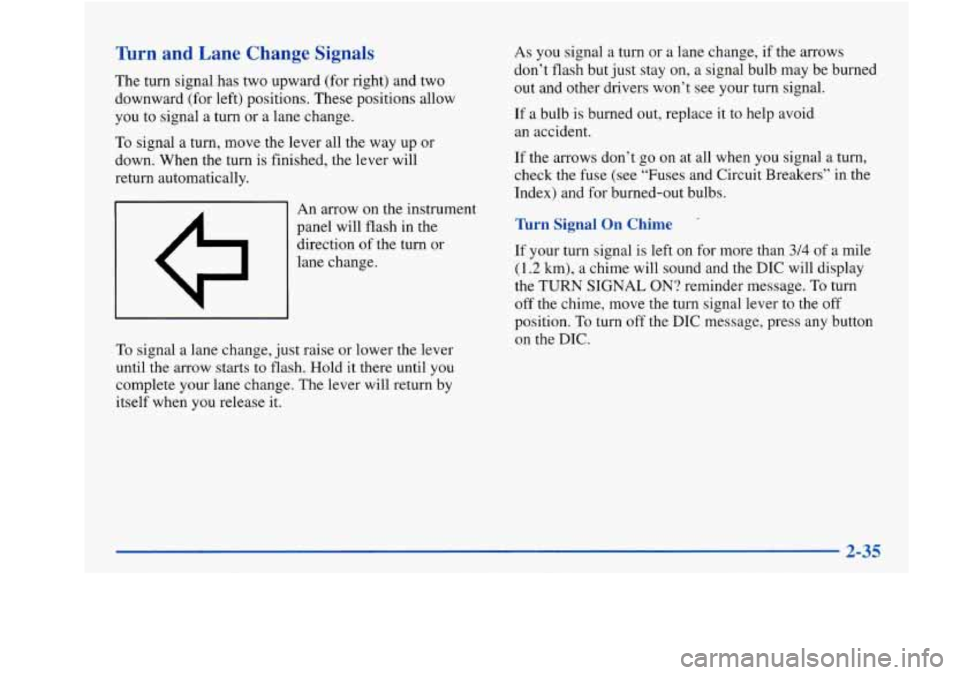
Turn and Lane Change Signals
The turn signal has two upward (for right) and two
downward (for left) positions. These positions allow
you to signal a turn or a lane change.
To signal a turn, move the lever all the way up or
down. When the turn is finished, the lever will
return automatically.
I 1 An arrow on the instrument
panel will flash in the
direction of the turn or
lane change.
To signal a lane change, just raise or lower the lever
until the arrow starts to flash.
Hold it there until you
complete your lane changp The lever will return
bv
itself when you release it. As
you signal
a turn or a lane change, if the arrows
don’t flash but just stay on, a signal bulb may be burned
out and other drivers won’t see your turn signal.
If a bulb
is burned out, replace it to help avoid
an accident.
If the arrows don’t
go on at all when you signal a turn,
check the fuse (see “Fuses and Circuit Breakers” in the
Index) and for burned-out bulbs.
Turn Signal On Chime
If your turn signal is left on for more than 3/4 of a mile
(1.2 km),
a chime will sound and the DIC will display
the TURN SIGNAL ON? reminder message.
To turn
off the chime, move the turn signal lever to the
off
position. To turn off the DIC message, press any button
on the DIC.
Page 111 of 380
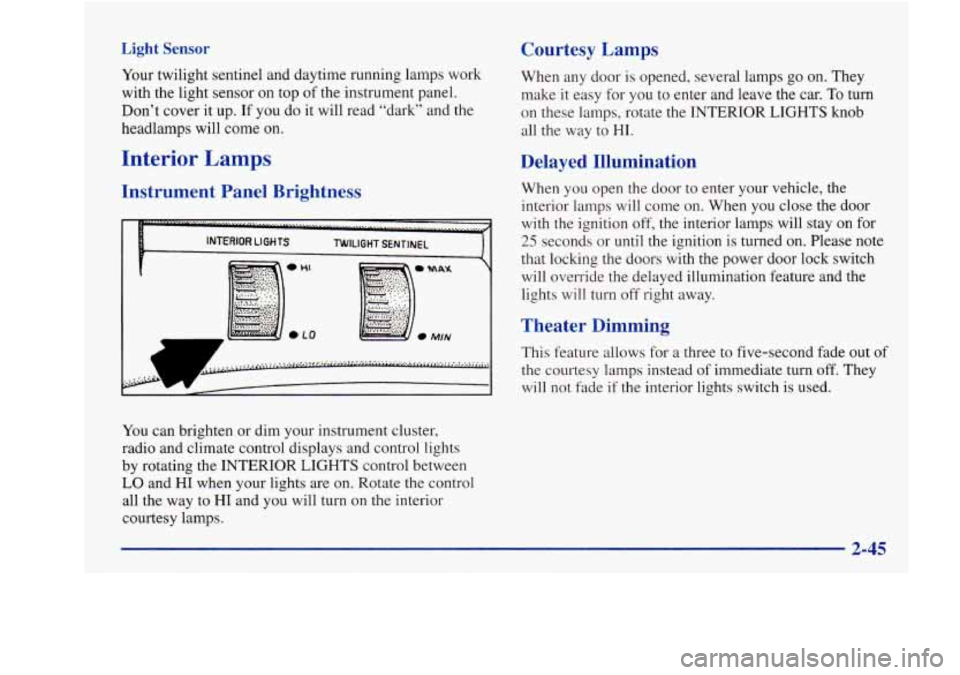
Light Sensor
Your twilight sentinel and daytime running lamps work
with the light sensor on
top of the instrument panel.
Don’t cover it up. If you do it will read “dark” and the
headlamps will come on.
Interior Lamps
Courtesy Lamps
When any door is opened, several lamps go on. They
make it easy for you to enter and leave the car.
To turn
on these lamps, rotate the INTERIOR LIGHTS knob
all the way to HI.
Instrument Panel Brightness Delayed Illumination When you
open the door to enter your vehicle, the
interior lamps will come on. When you close the door
with the ignition off, the interior lamps will stay on for
25 seconds or until the ignition is turned on. Please note
that locking the doors with the power door lock switch
will override the delayed illumination feature and the
lights will turn off right away.
Theater Dimming
This feature allows for a three to five-second fade out of
the courtesy lamps instead of immediate turn off. They
will not fade if the interior lights switch is used.
You can brighten or dim your instrument cluster,
radio and climate control displays and control lights
by rotating the
INTERIOR LIGHTS control between
LO and HI when your lights are on. Rotate the control
all the way to HI and you will turn
on the interior
courtesy lamps.
2-45
Page 112 of 380

Parade Dimming
This feature prohibits the dimming of your instrument
displays during daylight while your headlamps are on.
This feature operates with the light sensor for the
twilight sentinel and is fully automatic. When the
light sensor reads darkness outside, you will be able
to dim your instrument panel displays once again.
Perimeter Lighting
When the UNLOCK button on the remote lock control
transmitter is pressed, the headlamps, parking lamps,
back-up lamps and cornering lamps will come on
if it is
dark enough outside according to the twilight sentinel.
Exit Lighting
With this feature, the interior lamps will come on for
25 seconds after you remove the key from the ignition.
This will give you time to find the door pull handle or
lock switches when you exit the vehicle.
Illuminated Entry
Press the UNLOCK button on the remote lock control
transmitter and the interior courtesy lamps will come on
and stay on for up to a minute. The lamps will turn
off
immediately by pressing the LOCK button on the
remote lock control transmitter, starting the ignition or
activating the power door locks. This
option can be programmed on or
off for each
driver’s transmitter.
To turn the feature off
1. Turn the ignition key to OFF
2. Press and hold the door lock switch throughout this
procedure. All doors will lock.
3. Press the instant alarm button on the remote lock
control transmitter. Perimeter lighting remains on at
this time and the horn will chirp two times.
4. Press the instant alarm button on the remote lock
control transmitter again. Perimeter lighting is
disabled and the horn will chirp one time.
5. Release the door lock switch. The perimeter lighting
option is now
off.
2-46
Page 115 of 380

Mirror Operation
When set in the MIRROR position, this mirror
automatically changes to reduce glare
from headlamps
behind you.
A time delay feature prevents rapid
changing from the day to night positions while driving
under lights and through traffic.
The mirror
also includes an eight-point compass display
in the upper right corner of the mirror face. When on, the
compass automatically calibrates as the vehicle is driven.
When cleaning the mirror, use a paper towel or similar
material dampened with glass cleaner.
Do not spray
glass cleaner directly on the mirror as that may cause
the liquid cleaner to enter the mirror housing. Use a
cotton swab and glass cleaner to clean the photocells
when necessary. The right side
of the switch located at the bottom
of the
mirror
turns the electrochromic mirror on and off. To
turn on the automatic dimming feature, press MIRROR.
To turn off automatic dimming, press MIRROR again.
The green indicator light will be illuminated when
this
feature is active.
Compass Operation
Press the COMPASS switch once to turn the compass
on or
off.
When the ignition and the compass feature are on, the
compass
will show two character boxes for
approximately
two seconds. After two seconds, the
mirror will display the compass heading.
2-49
Page 116 of 380

If, after two seconds, the display does not show a
compass heading
(“N’ for North, for example), there
may be a strong magnetic field interfering with the
compass. Such interference may be caused by a
magnetic antenna mount, magnetic note pad holder
or a similar magnetic item.
Compass Variance
The mirror is set in zone eight upon leaving the factory.
It will be necessary to adjust the compass to compensate
for compass variance if you live outside zone eight.
Under certain circumstances, as during a long distance
cross-country trip, it will be necessary to adjust for
compass variance. Compass variance
is the difference
between earth’s magnetic north and true geographic
north. If not adjusted
to account for compass variance,
your compass could give false readings.
To adjust
for compass variance:
1. Use the COMPASS button located at the bottom of
the mirror.
2. Press and hold the COMPASS button until a zone
number appears in the display.
on the following zone map.
3. Find your current location and variance zone number
4. Press the COMPASS button on the bottom of
the mirror until the new zone number appears
in the display. After you stop pressing the
button, the compass will need to be calibrated.
(This is the automatic calibration mode. Drive in
a circle to calibrate the mirror. See “Compass
Calibration” following.)
2-50
Page 117 of 380

Compass Calibration
If the letter “C” should ever appear in the compass
window, the compass may need calibration.
The mirror can be calibrated in one of two ways:
0 Drive the vehicle in circles at five mph (8 km/h) or
less until the display reads a direction, or
0 Drive the vehicle on your everyday routine.
Power Remote Control Mirror
The controls on the far
left of the instrument
panel control both outside
rearview mirrors. Move
the center switch to the
left to select the driver’s
side rearview mirror, or
to the right to select the
passenger’s side
rearview mirror.
To lock the controls, leave the selector switch in the
middle position.
When you operate the rear window defogger, a defogger
also warms the driver’s and passenger’s outside
rearview mirrors to help clear them of ice and snow.
Your vehicle
is equipped with the memory function. The
mirror positions, along with the driver’s set position, can
be stored into memory. See “Memory Seat and Mirrors”
in the Index.
Parallel Park Assist Mirror
The passenger’s outside rearview mirror also includes a
tilt-down feature that operates when the shift lever is in
reverse. This feature assists the driver with improved
rear obstacle detection.
Move the power remote control mirror switch to the
left
(L) or center position to enable this feature. Move
the switch to the right
(R) to turn this feature off.
Then press the arrows
to adjust each mirror so that you
can just see the side
of your vehicle when you are sitting
in a comfortable driving position.
2-51
Page 130 of 380
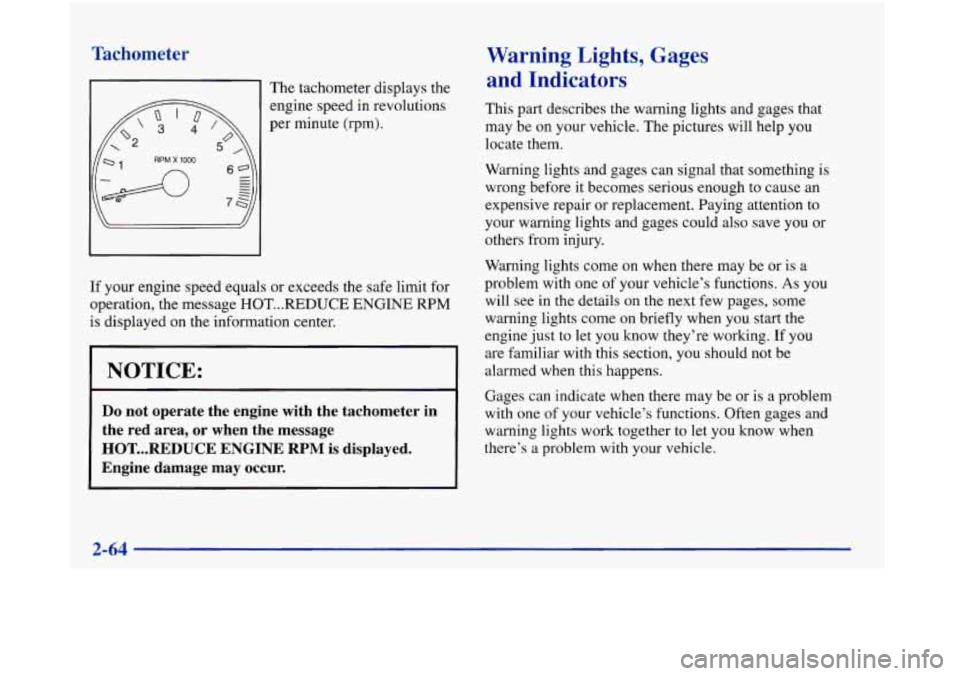
Tachometer
RPM X 1000
The tachometer displays the
engine speed in revolutions
per minute (rpm).
If
your engine speed equals or exceeds the safe limit for
operation, the message
HOT ... REDUCE ENGINE RPM
is displayed on the information center.
I NOTICE:
Do not operate the engine with the tachometer in
the red area, or when the message
HOT. ..REDUCE ENGINE RPM is displayed.
Engine damage may occur.
Warning Lights, Gages
and Indicators
This part describes the warning lights and gages that
may be
on your vehicle. The pictures will help you
locate them.
Warning lights and gages can signal that something is
wrong before it becomes serious enough to cause an
expensive repair or replacement. Paying attention to
your warning lights and gages could also save you or
others from injury.
Warning lights come on when there may be or is a
problem with one of your vehicle’s functions.
As you
will see in the details
on the next few pages, some
warning lights come on briefly when you start the
engine just to let
you know they’re working. If you
are familiar with this section, you should not be
alarmed when this happens.
Gages can indicate when there may be or is a problem
with one of your vehicle’s functions. Often gages and
warning lights work together to
let you know when
there’s a problem with your vehicle.
2-64
- -
Page 140 of 380
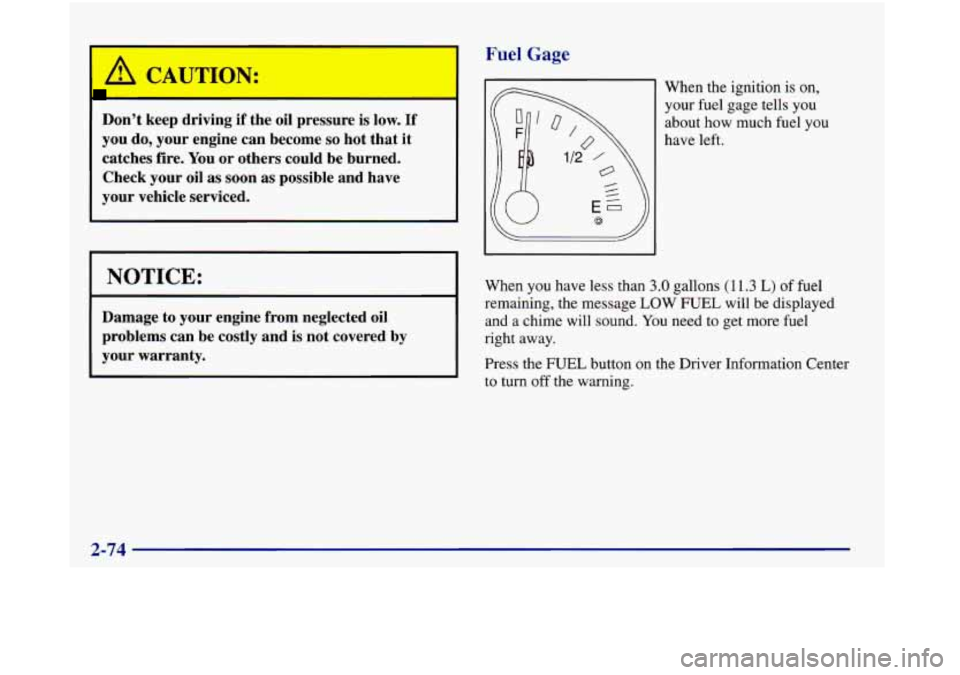
CAUTION:
Don’t keep driving if the oil pressure is low. If
you do, your engine can become so hot that it
catches fire. You or others could be burned.
Check your oil
as soon as possible and have
your vehicle serviced.
I NOTICE:
Damage to your engine from neglected oil
problems can be costly and is not covered by
your warranty.
Fuel Gage
When the ignition is on,
your fuel gage tells you
about how much fuel you
have left.
When you have less than
3 .O gallons (1 1.3 L) of fuel
remaining, the message LOW FUEL will be displayed
and a chime will
sound. You need to get more fuel
right away.
Press the FUEL button on the Driver Information Center
to turn off the warning.